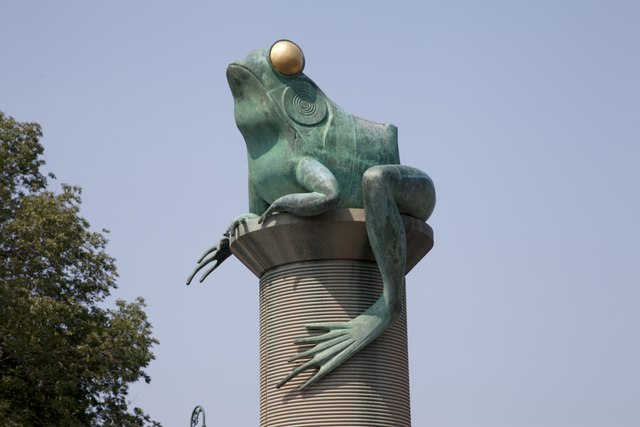When the Frogs Attacked (Kind Of)

In May of 1754, war broke out in what would become the United States and Canada. Great Britain and the Kingdom of France were the two main belligerents, each backed by their North American settlers and some Native American tribes. The war, dubbed the French and Indian War, took place mostly near the eastern coast of the continent, as seen on this map, but — by and large — the great state (then colony) of Connecticut never found itself to be part of any major advances. That wasn’t obviously going to be the case, though, when the war began, hundreds of Connecticut men enlisted to fight, and many of the colony’s towns feared that their backyards would become a battleground.
Which is why the statue above exists.
Yes, the picture above is of an ugly-looking version of a frog, with big gold eyes and creepy webbed feet. There are four such frogs positioned on the corners of something called “Frog Bridge, which, “outside of the frogs,” per Wikipedia’s editors, “is more like a conventional highway bridge.” Here’s a picture of it from December of 2018, and as you can see, that seems to be a fair description of the otherwise nondescript bridge — it hardly warrants such a set of adornments. But the town the bridge lives in, Windham, Connecticut, deserves credit for having a sense of humor.
In June of 1754, the French and Indian War was top of mind for the thousand or so people then living in Windham, and as was the case for those throughout the region. One morning, though, the war came to Windham, or so it seemed. As the New England Historical Society recounts, “the residents of the town of Windham woke to a hideous sound, a shrieking, clattering roar. The frightened townspeople jumped from their beds. Some thought the horrifying sounds were the war-whoops of attacking Indians. Some thought they were the trumpets of Judgment Day. Others thought they were Native Americans saying ‘gin’ and ‘rum.'” In any event, the town was convinced: they were under attack. The town militia snapped into action, with the members firing into the darkness. And it seemed to work — the shrieking stopped.
The next morning, the townspeople set out to search for the attackers — and found dead bodies everywhere. Not Native Americans, not French colonists, nor anyone claiming to be bringing Judgment Day forward. They found a lot of dead frogs.
The spring and early summer in Connecticut that year were unusually warm and dry, and for the frogs of Windham, that was an issue. Per ConnecticutHistory.org, “a long-standing drought had reduced the entire area’s standing water to a single small pond and every frog for miles around had descended on the Windham area in a desperate search for water. The jostling and battling of these frogs, and their struggle to gain access to the area’s only remaining water, had been the source of the previous night’s unearthly din. In the aftermath of the night’s melee, hundreds of bullfrog corpses littered the landscape.” The town wasn’t under attack — they were the last resort — and an unsuccessful one at that — for the area’s amphibian population.
At first, the people of Windham were embarrassed by their assumption that they were under attack, but later, they took ownership of their mistake and turned it into a point of pride. The town has adopted the frog as its mascot and made the Battle of the Frogs a central point in the town’s history and pride. Even the town’s official seal, seen here, features an image of a frog.
Bonus fact: “The Frog Prince” is a famous fairy tale in which a princess comes across a frog and ends up befriending the animal, ultimately kissing it. To the princess’s surprise, her kiss transforms the frog into a prince; he had been cursed by an evil witch, who (for some reason) decided to allow the curse to be reversed in the unlikely situation that someone kissed the frog. The parable is supposed to teach young children that beauty is just skin deep. But the original tale, published by the Brothers Grimm in 1812, wouldn’t have had kids kissing frogs. In that version, the frog is tired and wants to sleep in the princess’s bed, but the princess gets mad at him and throws him against the wall — the impact breaks the curse. It’s unclear when, or how, the kiss became part of the story.
From the Archives: Why Frogs Ribbit: Frogs probably don’t make the sound you think they make.
